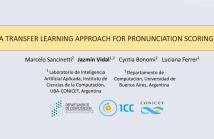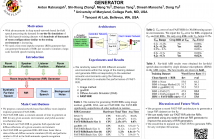- Acoustic Modeling for Automatic Speech Recognition (SPE-RECO)
- General Topics in Speech Recognition (SPE-GASR)
- Large Vocabulary Continuous Recognition/Search (SPE-LVCR)
- Lexical Modeling and Access (SPE-LEXI)
- Multilingual Recognition and Identification (SPE-MULT)
- Resource constrained speech recognition (SPE-RCSR)
- Robust Speech Recognition (SPE-ROBU)
- Speaker Recognition and Characterization (SPE-SPKR)
- Speech Adaptation/Normalization (SPE-ADAP)
- Speech Analysis (SPE-ANLS)
- Speech Coding (SPE-CODI)
- Speech Enhancement (SPE-ENHA)
- Speech Perception and Psychoacoustics (SPE-SPER)
- Speech Production (SPE-SPRD)
- Speech Synthesis and Generation, including TTS (SPE-SYNT)

- Read more about Towards Transferable Speech Emotion Representation: On Loss Functions For Cross-Lingual Latent Representations
- Log in to post comments
In recent years, speech emotion recognition (SER) has been used in wide ranging applications, from healthcare to the commercial sector. In addition to signal processing approaches, methods for SER now also use deep learning techniques which provide transfer learning possibilities. However, generalizing over languages, corpora and recording conditions is still an open challenge. In this work we address this gap by exploring loss functions that aid in transferability, specifically to non-tonal languages.
- Categories:
 32 Views
32 Views
Phone-level pronunciation scoring is a challenging task, with performance far from that of human annotators. Standard systems generate a score for each phone in a phrase using models trained for automatic speech recognition (ASR) with native data only. Better performance has been shown when using systems that are trained specifically for the task using non-native data. Yet, such systems face the challenge that datasets labelled for this task are scarce and usually small.
2022-ICASSP (1).pdf
- Categories:
 38 Views
38 Views
- Read more about THE VICOMTECH AUDIO DEEPFAKE DETECTION SYSTEM BASED ON WAV2VEC2 FOR THE 2022 ADD CHALLENGE
- Log in to post comments
This paper describes our submitted systems to the 2022 ADD challenge withing the tracks 1 and 2. Our approach is based on the combination of a pre-trained wav2vec2 feature extractor and a downstream classifier to detect spoofed audio. This method exploits the contextualized speech representations at the different transformer layers to fully capture discriminative information. Furthermore, the classification model is adapted to the application scenario using different data augmentation techniques.
- Categories:
 66 Views
66 Views
- Read more about CARINA – A CORPUS OF ALIGNED GERMAN READ SPEECH INCLUDING ANNOTATIONS
- Log in to post comments
This paper presents the semi-automatically created Corpus of Aligned Read Speech Including Annotations (CARInA), a speech corpus based on the German Spoken Wikipedia Corpus (GSWC). CARInA tokenizes, consolidates and organizes the vast, but rather unstructured material contained in GSWC. The contents are grouped by annotation completeness, and extended by canonic, morphosyntactic and prosodic annotations. The annotations are provided in BPF and TextGrid format.
- Categories:
 31 Views
31 Views
- Categories:
 14 Views
14 Views
- Read more about FAST-RIR: FAST NEURAL DIFFUSE ROOM IMPULSE RESPONSE GENERATOR
- Log in to post comments
We present a neural-network-based fast diffuse room impulse response generator (FAST-RIR) for generating room impulse responses (RIRs) for a given acoustic environment. Our FAST-RIR takes rectangular room dimensions, listener and speaker positions, and reverberation time as inputs and generates specular and diffuse reflections for a given acoustic environment. Our FAST-RIR is capable of generating RIRs for a given input reverberation time with an average error of 0.02s.
- Categories:
 71 Views
71 Views
- Read more about Transfer Learning for Robust Low-Resource Children's Speech ASR with Transformers and Source-Filter Warping
- Log in to post comments
Automatic Speech Recognition (ASR) systems are known to exhibit difficulties when transcribing children's speech. This can mainly be attributed to the absence of large children’s speech corpora to train robust ASR models and the resulting domain mismatch when decoding children’s speech with systems trained on adult data. In this paper, we propose multiple enhancements to alleviate these issues. First, we propose a data augmentation technique based on the source-filter model of speech to close the domain gap between adult and children's speech.
- Categories:
 15 Views
15 Views
- Read more about Characterizing the adversarial vulnerability of speech self-supervised learning
- Log in to post comments
A leaderboard named Speech processing Universal PERformance Benchmark (SUPERB), which aims at benchmarking the performance of a shared self-supervised learning (SSL) speech model across various downstream speech tasks with minimal modification of architectures and a small amount of data, has fueled the research for speech representation learning. The SUPERB demonstrates speech SSL upstream models improve the performance of various downstream tasks through just minimal adaptation.
- Categories:
 8 Views
8 Views
- Read more about Adversarial sample detection for speaker verification by neural vocoders
- Log in to post comments
Automatic speaker verification (ASV), one of the most important technology for biometric identification, has been widely adopted in security-critical applications. However, ASV is seriously vulnerable to recently emerged adversarial attacks, yet effective countermeasures against them are limited. In this paper, we adopt neural vocoders to spot adversarial samples for ASV.
- Categories:
 20 Views
20 Views